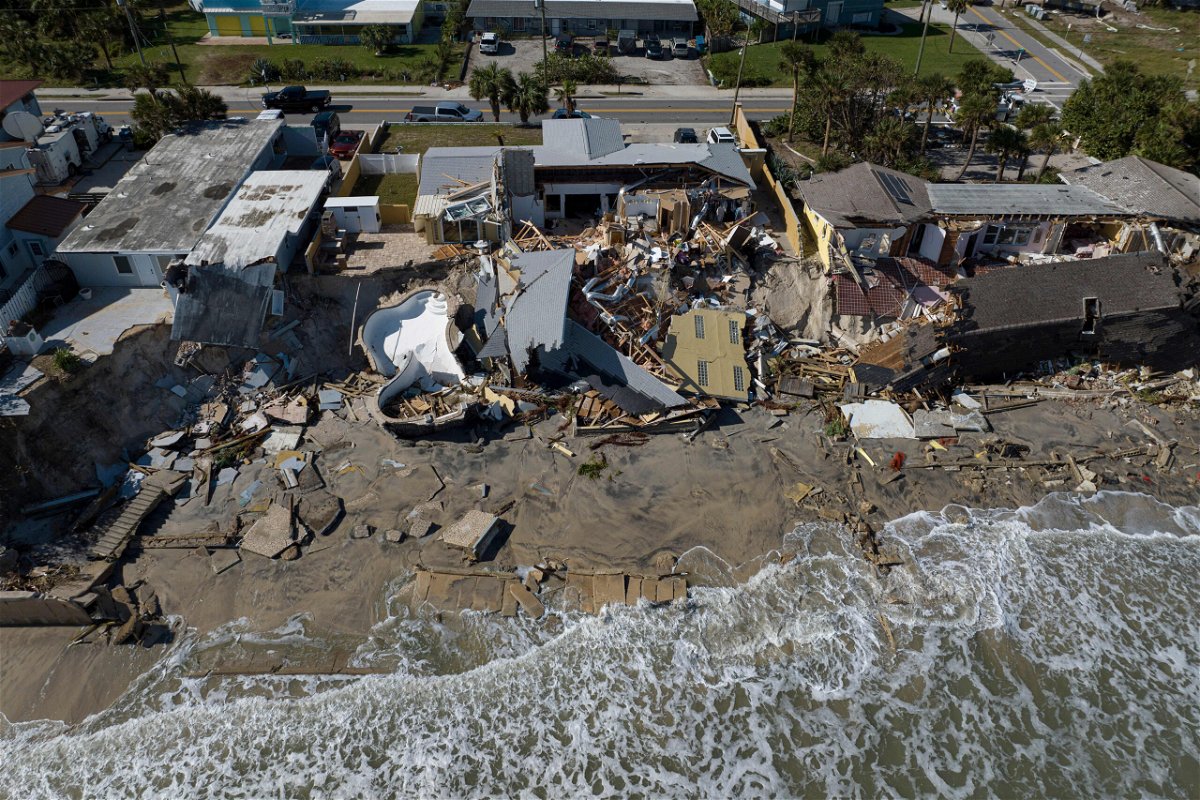Nicole becomes post-tropical cyclone, brings rain to Northeast after leaving a trail of destruction in Florida

An aerial view of destroyed beachfront homes in the aftermath of Hurricane Nicole at Daytona Beach
By Nouran Salahieh, CNN
After wreaking havoc in Florida, Nicole weakened into a post-tropical cyclone, bringing severe thunderstorms to the Carolinas and Virginia Friday before striking the Northeast.
Nicole — the first hurricane to hit the US in the month of November in nearly 40 years — walloped coastal homes in Florida’s Daytona area early Thursday and left five people dead after hitting the state’s eastern coast as a Category 1 hurricane.
The storm’s remnants are now expected to track to the Northeast and eastern Canada through Saturday, with heavy rain and gusty winds spreading from the Mid-Atlantic and Ohio Valley to New England overnight, according to the National Hurricane Center.
Nicole is expected to produce an additional 1 to 3 inches of rain across parts of the Eastern seaboard through Saturday morning, before pushing off-shore and away from the Atlantic coast.
The central Appalachians and northern Mid-Atlantic areas, particularly in the Blue Ridge Mountains, were expected to see Isolated flash, urban and small stream flooding.
Heavy rain and isolated flooding are also expected across New England through early Saturday.
While many people in the Carolinas and Georgia were under wind advisories earlier Friday, areas of Massachusetts, New Jersey and New York remain under one until Saturday morning, according to the National Weather Service. Gusts of up to 50 mph were possible.
The system will continue to weaken as it moves northward Saturday, and its tropical moisture will be absorbed by a separate cold front, which delivered blizzard conditions across the northern Plains.
“The risk of excessive rainfall and localized flash flooding with this extratropical transition will continue to diminish through Saturday,” the prediction center said.
Destruction along Florida’s eastern coastline
As the storm moves away from the Sunshine State, the damage left behind in Florida’s Volusia County coast is clear to see.
Beachfront homes and hotels have collapsed into the ocean. At least 49 beachfront properties, including hotels and condos, have been deemed “unsafe,” according to county officials.
“The Volusia Coast has been devastated by hurricanes Ian and Nicole,” Volusia County Beach Safety Capt. A.J. Miller said in a video statement Friday. “Damage assessments from these two storms combined have totaled in the hundreds of millions of dollars with over 30 homes and two dozen hotels and condos that have been evacuated.”
Buildings in the area were battered by Hurricane Ian just weeks before Nicole’s arrival, and were further threatened by coastal erosion as incoming Nicole pushed rising ocean water onshore on top of exceptionally high tides.
When Nicole arrived, it tore through homes in Wilbur-By-The-Sea, a barrier island community off Daytona Beach.
Among the badly damaged structures on the island was Nina Lavigna’s home. She lost 33 years of memorabilia in the storm, Lavigna told CNN affiliate WESH.
Nicole during landfall ripped Lavigna’s bedrooms away from the rest of her house, leaving the home exposed to the ocean and badly damaged. In the rooms left standing, her granddaughters pink shoes could be seen among the rubble.
On Friday, Lavigna said she flagged down Florida Gov. Ron DeSantis as he toured the wreckage.
“I asked him if he could send us some help. Because we need some help here,” she said.
DeSantis said on social media the state is “committed to restoring our communities and beaches.”
“Florida’s Atlantic Coast has been hit hard by 2 storms in less than 2 months. Dozens of buildings have been condemned or destroyed by erosion,” the governor tweeted Thursday. The state “will use $20 million for emergency sand placement,” he said.
As residents navigate the storm’s aftermath, Miller warned there are still dangers on the beach as recovery efforts continue. The storm left a multitude of hazards residents must maneuver in the hurricane’s wake.
“The amount of destruction is unprecedented and the beach is littered with massive amounts of debris, both in the water and onshore,” Miller said.
At least five people were killed in the storm. In Florida’s Orange County, two people died after being “electrocuted by a downed power line,” the sheriff’s office said in a news release. Another two deaths are being investigated as possibly storm-related following a fatal car accident, according to Orange County Mayor Jerry Demings.
Also killed was a 68-year-old Port Canaveral man who had been on a yacht early Thursday morning as it was “being battered by the waves and the dock,” the Cocoa Police Department said.
The-CNN-Wire
™ & © 2022 Cable News Network, Inc., a Warner Bros. Discovery Company. All rights reserved.
CNN’s Haley Brink, Derek Van Dam, Theresa Waldrop, Melissa Alonso and Caroll Alvarado contributed to this report.